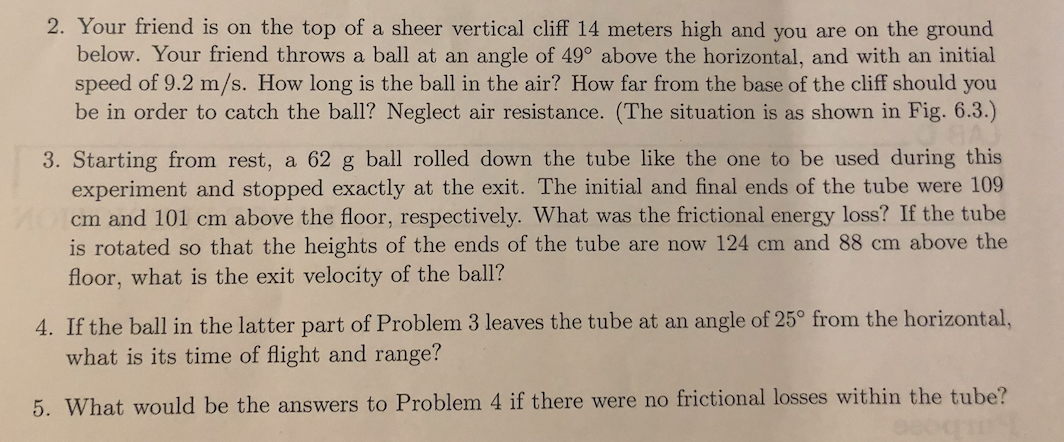2. Your friend is on the top of a sheer vertical cliff 14 meters high and you are on the ground below. Your friend throws a ball at an angle of 49° above the horizontal, and with an initial speed of 9.2 m/s. How long is the ball in the air? How far from the base of the cliff should you be in order to catch the ball1? Neglect air resistance. (The situation is as shown in Fig. 6.3.) 3. Starting from rest, a 62 g ball rolled down the tube like the one to be used during this experiment and stopped exactly at the exit. The initial and final ends of the tube were 109 Ocm and 101 cm above the floor, respectively. What was the frictional energy loss? If the tube is rotated so that the heights of the ends of the tube are now 124 cm and 88 cm above the floor, what is the exit velocity of the ball? 4. If the ball in the latter part of Problem 3 leaves the tube at an angle of 25° from the horizontal, what is its time of flight and range? 5. What would be the answers to Problem 4 if there were no frictional losses within the tube?
2. Your friend is on the top of a sheer vertical cliff 14 meters high and you are on the ground below. Your friend throws a ball at an angle of 49° above the horizontal, and with an initial speed of 9.2 m/s. How long is the ball in the air? How far from the base of the cliff should you be in order to catch the ball1? Neglect air resistance. (The situation is as shown in Fig. 6.3.) 3. Starting from rest, a 62 g ball rolled down the tube like the one to be used during this experiment and stopped exactly at the exit. The initial and final ends of the tube were 109 Ocm and 101 cm above the floor, respectively. What was the frictional energy loss? If the tube is rotated so that the heights of the ends of the tube are now 124 cm and 88 cm above the floor, what is the exit velocity of the ball? 4. If the ball in the latter part of Problem 3 leaves the tube at an angle of 25° from the horizontal, what is its time of flight and range? 5. What would be the answers to Problem 4 if there were no frictional losses within the tube?
University Physics Volume 1
18th Edition
ISBN:9781938168277
Author:William Moebs, Samuel J. Ling, Jeff Sanny
Publisher:William Moebs, Samuel J. Ling, Jeff Sanny
Chapter4: Motion In Two And Three Dimensions
Section: Chapter Questions
Problem 56P: Olympus Mons on Mars is the largest volcano in the solar system, at a height of 25 km and with a...
Related questions
Question

Transcribed Image Text:2. Your friend is on the top of a sheer vertical cliff 14 meters high and you are on the ground
below. Your friend throws a ball at an angle of 49° above the horizontal, and with an initial
speed of 9.2 m/s. How long is the ball in the air? How far from the base of the cliff should you
be in order to catch the ball1? Neglect air resistance. (The situation is as shown in Fig. 6.3.)
3. Starting from rest, a 62 g ball rolled down the tube like the one to be used during this
experiment and stopped exactly at the exit. The initial and final ends of the tube were 109
Ocm and 101 cm above the floor, respectively. What was the frictional energy loss? If the tube
is rotated so that the heights of the ends of the tube are now 124 cm and 88 cm above the
floor, what is the exit velocity of the ball?
4. If the ball in the latter part of Problem 3 leaves the tube at an angle of 25° from the horizontal,
what is its time of flight and range?
5. What would be the answers to Problem 4 if there were no frictional losses within the tube?
Expert Solution
This question has been solved!
Explore an expertly crafted, step-by-step solution for a thorough understanding of key concepts.
This is a popular solution!
Trending now
This is a popular solution!
Step by step
Solved in 6 steps with 3 images

Recommended textbooks for you

University Physics Volume 1
Physics
ISBN:
9781938168277
Author:
William Moebs, Samuel J. Ling, Jeff Sanny
Publisher:
OpenStax - Rice University

Principles of Physics: A Calculus-Based Text
Physics
ISBN:
9781133104261
Author:
Raymond A. Serway, John W. Jewett
Publisher:
Cengage Learning

University Physics Volume 1
Physics
ISBN:
9781938168277
Author:
William Moebs, Samuel J. Ling, Jeff Sanny
Publisher:
OpenStax - Rice University

Principles of Physics: A Calculus-Based Text
Physics
ISBN:
9781133104261
Author:
Raymond A. Serway, John W. Jewett
Publisher:
Cengage Learning